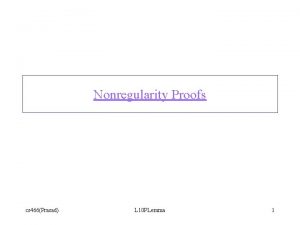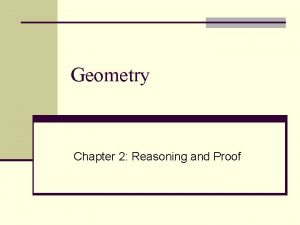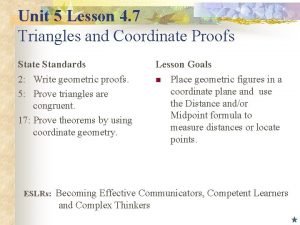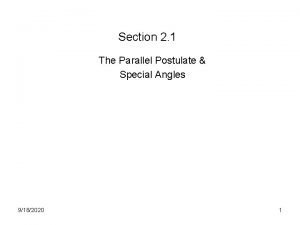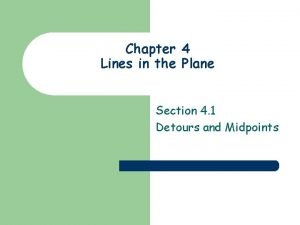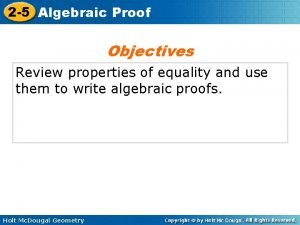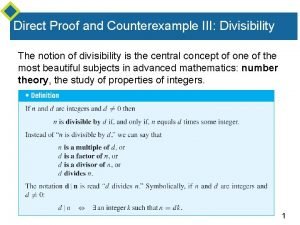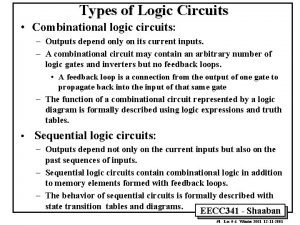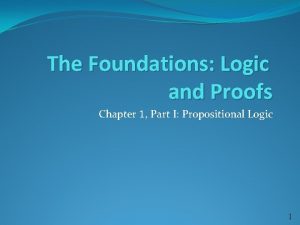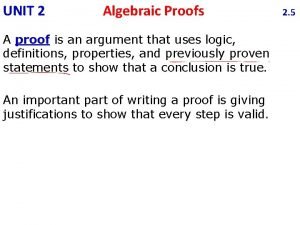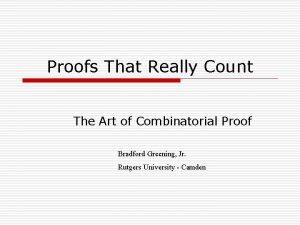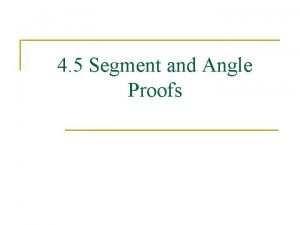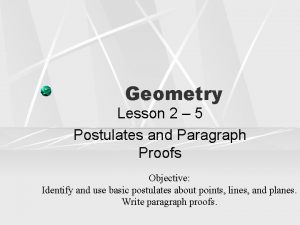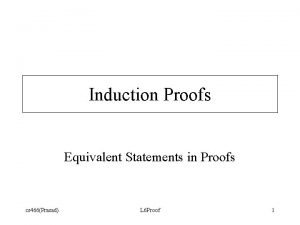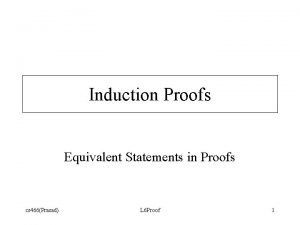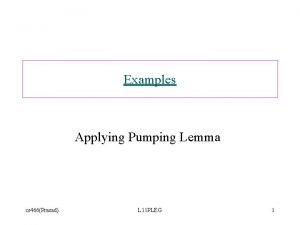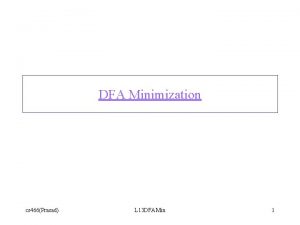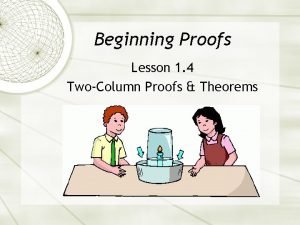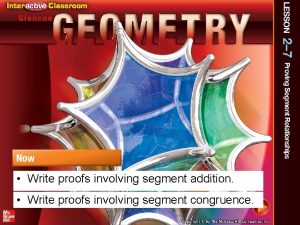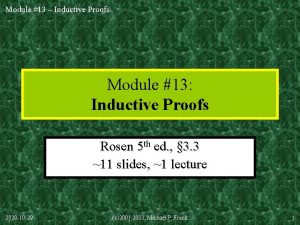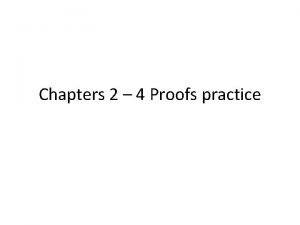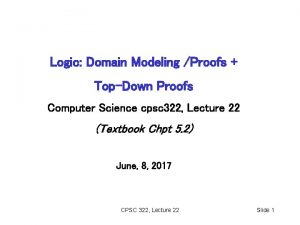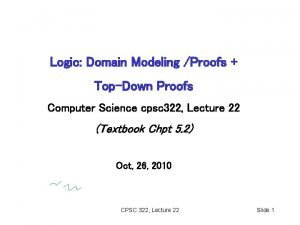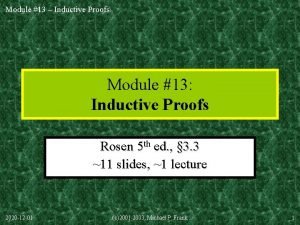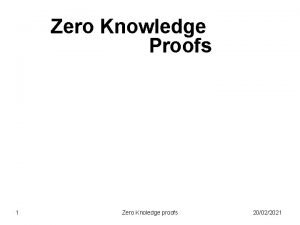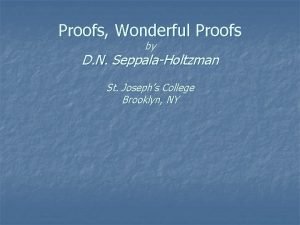Nonregularity Proofs cs 466Prasad L 10 PLemma 1
















- Slides: 16

Nonregularity Proofs cs 466(Prasad) L 10 PLemma 1

Regular Languages: Grand Unification (Parallel Simulation) (Rabin and Scott’s work) (Collapsing graphs; Structural Induction) (S. Kleene’s work) (Construction) (Solving linear equations) cs 466(Prasad) L 10 PLemma 2

Role of various representations for Regular Languages • Closure under complementation. (DFAs) • Closure under union, concatenation, and Kleene star. (NFA-ls, Regular expression. ) • Consequence: Closure under intersection by De Morgan’s Laws. • Relationship to context-free languages. (Regular Grammars. ) • Ease of specification. (Regular expression. ) • Building tokenizers/lexical analyzers. (DFAs) cs 466(Prasad) L 10 PLemma 3

Consider pairs of strings: If L were regular, then there exists a DFA M accepting L with the following property: cs 466(Prasad) L 10 PLemma 4

CLAIM: JUSTIFICATION: Otherwise, from the definition of DFA, which contradicts the earlier conclusion. In order to satisfy the machine M must have a unique state for every i. Thus, M must have infinite number of states, if L is regular. This violates the definition of DFA. So, L must be non-regular. cs 466(Prasad) L 10 PLemma 5

Using Closure Properties • Regular languages are closed under set-intersection. L 1=bit strings with even parity L 2=bit strings with number of 1’s divisible by 3 L=bit strings with number of 1’s a multiple of 6 • Note that regularity is a property of a collection, and not a property of an individual string in the collection. cs 466(Prasad) L 10 PLemma 6

• If R is a regular language and C is context-free, then may not be regular. • Proof: • Show that is not regular. • Proof: If L were regular, ought to be regular. However, is known to be non-regular. Hence, L cannot be regular. cs 466(Prasad) L 10 PLemma 7

DIGRESSION • If R is a regular language and C is context-free, then can be regular. • Proof: • • • L = {/, ab, ba, aabb, abab, abba, baba, bbaa, …} a*b* = {/, a, b, aa, ab, bb, …, aabb, …} C = {/, ab, aabb, …} intersect(a*b*, C) =intersect(L, a*b*) = C union(a*b*, C) = a*b* ; union(L, C) = L cs 466(Prasad) L 10 PLemma 8

Prelude to Pumping Lemma • Is 46551 divisible by 46? • Is 46554 divisible by 46? • Is 46552 divisible by 46? Necessary vs sufficient condition cs 466(Prasad) L 10 PLemma 9

Pumping Lemma for Regular Languages • It is a necessary condition. – Every regular language satisfies it. – If a language violates it, it is not regular. • RL => PL not PL => not RL • It is not a sufficient condition. – Not every non-regular language violates it. • not RL =>? PL or not PL (no conclusion) cs 466(Prasad) L 10 PLemma 10

Basic Idea: b q 0 a q 1 b a q 2 cs 466(Prasad) a a, b L 10 PLemma b q 3 11

Note, So, cs 466(Prasad) L 10 PLemma 12

Fundamental Observation • Given a “sufficiently” long string, the states of a DFA must repeat in an accepting computation. These cycles can then be used to predict (generate) infinitely many other strings in (of) the language. Pigeon-Hole Principle cs 466(Prasad) L 10 PLemma 13

Pumping Lemma (Theorem 7. 3. 3) • Let L be a regular language that is accepted by a DFA M with k states. Let z be any string in L with. Then z can be decomposed as uvw with cs 466(Prasad) L 10 PLemma 14

For all sufficiently long strings (z) These exists non-null prefix (uv) and substring (v) For all repetitions of the substring (v), we get strings in the language. cs 466(Prasad) L 10 PLemma 15

Proving non-regularity • If there exists an arbitrarily long string s L, and for each decomposition s = uvw, there exists an i such that , then L is non-regular. Negation of the necessary condition: cs 466(Prasad) L 10 PLemma 16
 Lesson 9 unknown angle proofs—writing proofs
Lesson 9 unknown angle proofs—writing proofs Unknown angle proofs-proofs with constructions
Unknown angle proofs-proofs with constructions Cs 466
Cs 466 Geometry chapter 2 proofs worksheet
Geometry chapter 2 proofs worksheet Coordinate plane proofs
Coordinate plane proofs Continued proofs transversals and special angles
Continued proofs transversals and special angles Detour proofs
Detour proofs Direct algebraic proof
Direct algebraic proof Divisibility proofs
Divisibility proofs Boolean algebra proofs
Boolean algebra proofs The foundations logic and proofs
The foundations logic and proofs Proving lines parallel proofs
Proving lines parallel proofs Unit 2 logic and proof homework 6 algebraic proof
Unit 2 logic and proof homework 6 algebraic proof What is a flowchart proof
What is a flowchart proof Proofs that really count
Proofs that really count Simple geometry proofs
Simple geometry proofs 2-5 postulates and paragraph proofs answers
2-5 postulates and paragraph proofs answers


